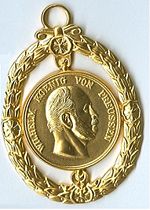
Wilhelm-Orden
Encyclopedia

William II, German Emperor
Wilhelm II was the last German Emperor and King of Prussia, ruling the German Empire and the Kingdom of Prussia from 15 June 1888 to 9 November 1918. He was a grandson of the British Queen Victoria and related to many monarchs and princes of Europe...
, and was dedicated to the memory of his grandfather Emperor William I
William I, German Emperor
William I, also known as Wilhelm I , of the House of Hohenzollern was the King of Prussia and the first German Emperor .Under the leadership of William and his Chancellor Otto von Bismarck, Prussia achieved the unification of Germany and the...
"the Great". Like the civil class of Pour le Mérite, the Wilhelm-Orden was intended as a high award for service to science and the arts.
The insignia of the Order consisted of a golden medal
Medal
A medal, or medallion, is generally a circular object that has been sculpted, molded, cast, struck, stamped, or some way rendered with an insignia, portrait, or other artistic rendering. A medal may be awarded to a person or organization as a form of recognition for athletic, military, scientific,...
with the portrait of William I, surrounded by a golden wreath and suspended from a heavy golden collar. This collar with a weight of 222 grams bore the words WIRKE IM ANDENKEN AN KAISER WILHELM DEN GROSSEN (English: "Work in the memory of Emperor William the Great") and was designed by the jewellers Emil Weigand en Otto Schultz.
The order was very exclusive. One of the first to be decorated was Otto von Bismarck
Otto von Bismarck
Otto Eduard Leopold, Prince of Bismarck, Duke of Lauenburg , simply known as Otto von Bismarck, was a Prussian-German statesman whose actions unified Germany, made it a major player in world affairs, and created a balance of power that kept Europe at peace after 1871.As Minister President of...
. Also among the recipients was physician and Nobel laureate
Nobel Prize in Physiology or Medicine
The Nobel Prize in Physiology or Medicine administered by the Nobel Foundation, is awarded once a year for outstanding discoveries in the field of life science and medicine. It is one of five Nobel Prizes established in 1895 by Swedish chemist Alfred Nobel, the inventor of dynamite, in his will...
Robert Koch
Robert Koch
Heinrich Hermann Robert Koch was a German physician. He became famous for isolating Bacillus anthracis , the Tuberculosis bacillus and the Vibrio cholerae and for his development of Koch's postulates....
.
There are other decorations with this or a similar name:
- The highest decoration for valour in the NetherlandsNetherlandsThe Netherlands is a constituent country of the Kingdom of the Netherlands, located mainly in North-West Europe and with several islands in the Caribbean. Mainland Netherlands borders the North Sea to the north and west, Belgium to the south, and Germany to the east, and shares maritime borders...
is the Military Order of William (1815) - The elector of Hesse-KasselHesse-KasselThe Landgraviate of Hesse-Kassel or Hesse-Cassel was a state in the Holy Roman Empire under Imperial immediacy that came into existence when the Landgraviate of Hesse was divided in 1567 upon the death of Philip I, Landgrave of Hesse. His eldest son William IV inherited the northern half and the...
(or Hesse-Cassel) instituted a "WilhelmsordenWilhelmsordenThe "Wilhelmsorden" of Hesse-Kassel was instituted by the Elector Friedrich Wilhelm I on 20 August 1851 as a civil and military Order of Merit...
" in 1851 in honor of Friedrich Wilhelm IFrederick William, Elector of HesseFrederick William I was, between 1847 and 1866, the last Elector of Hesse-Kassel .- Life :...
of Hesse.

